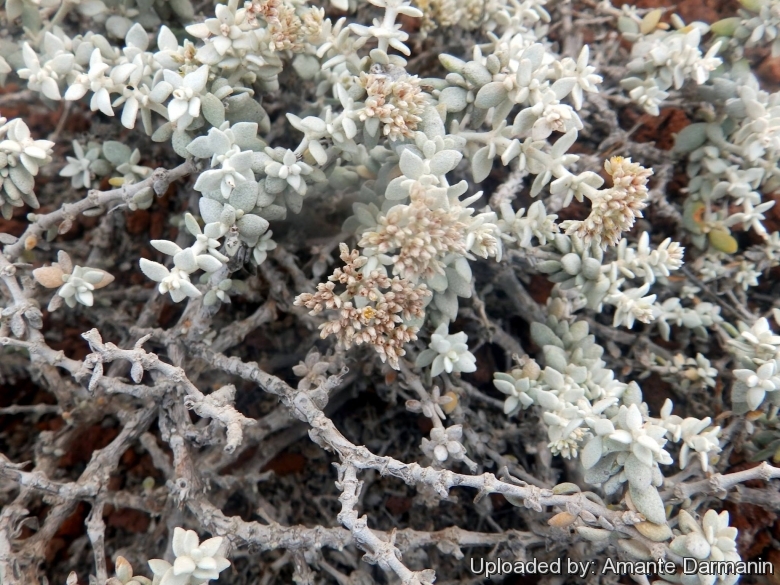
Polycarpaea nivea Photo by: Amante Darmanin
Origin and Habitat: Polycarpaea niveaSN|33714]]SN|33714]] is found in the dunes and rocks of the coast and also penetrates the interior of Mauritania, Canary Islands, Cape Verde and Morocco.
Habitat and ecology: Polycarpaea niveaSN|33714]]SN|33714]] is a coastal xerophyte growing in extremely arid to arid areas of several islands, typically on more or less compacted sand dunes close to the sea but also in coastal cliffs and stony coastal plains. It is also found in sub- humid to humid mountain areas. In the Canary it participates it forms psammophyte communities with Convolvulus caput-medusae and Heliotropium bacciferum ssp. erosum, Zygophyllum fontanesiiSN|33712]]SN|33712]] and Euphorbia paralias are also abundant here.
Synonyms:
See all synonyms of Polycarpaea nivea
back
Accepted name in llifle Database:Polycarpaea nivea (Aiton) WebbNiger Fl. [W. J. Hooker] 104. 1849 [Nov-Dec 1849]Synonymy: 14
back
Common Names include:
ENGLISH: Common white saladillo
SPANISH (Español): saladillo blanco
Description: Polycarpaea niveaSN|33714]]SN|33714]] is a woody, dense, cushion forming, sub-shrubs that grows in the dunes. The leaves are small, strongly succulent, silvery or more rarely brownish tomentose with acute to rounded apices. Various populations of P. nivea differ especially in colour colour and density of the indument, leaf shape and apices, and inter node length.
Derivation of specific name: The specific name “nivea” comes from the Latin that means white like the snow, alluding to the colour of the plant.
Leaves: Narrowly (ob)lanceolate or obovate, strongly succulent, thickly pubescent and silver colour and with the apex obtuse or sharp. The leaves shows a peculiar adaptation to aridity by having a functional type of leaf tissue, with large, roundish, water-filled cells in the middle of the transect and strongly thickened epidermal cells that again are hidden behind a dense hair cover.
Chromosome number: 2n = 18
Bibliography: Major references and further lectures
1) Wolfram Lobin “Courier Forschungsinstitut Senckenberg: CFS, Volume 159” Senckenbergische Naturforschende Gesellschaft, 1993
2) E. van der Maarel “Dry Coastal Ecosystems”, Volume 2 Elsevier, 1993
3) Per Sunding “The Vegetation of Gran Canaria” Univ.-Forlaget, 1972
4) Jahandiez, E. & R. Maire “Catalogue des Plantes du Maroc.” [vol. 2] Minerva, Lechevalier éds., Alger. [p.213] 1932.
5) Maire, R. “FLORE DE L'AFRIQUE DU NORD”. Lechevalier éd., Paris, [p.77]
6) Ozenda, P. “Flore du Sahara”. (ed. 2). Centre National de la Recherche Scientifique (CNRS.), Paris, 622p. [p.536] 1963. 1983.
7) Greuter, W., H. M. Burdenet & Long (ed.). “MED-CHECKLIST”. [vol. 1] Conservatoire & Jardin botaniques de la Ville de Genève. [p.241] 1984
8) Hansen, A. & P. Sunding “Flora of Macaronesia”. Checklist of vascular plants. 4. revised edition. Sommerfeltia 17: [1-295] 1993.
9) Fennane, M., M. Ibn Tattou, J. Mathez, A. Ouyahya & J. el Oualadi (éd.) “Flore pratique du Maroc”. vol. [1] Trav. Inst. Sci., Série Bot. 36. Rabat. [p.195] 1999.
10) Fennane, M. & M. Ibn Tattou “Flore vasculaire du Maroc. Inventaire et chorologie.” Trav. Inst. Sci. Univ. Mohammed V, Sér. Bot. 37: [124] 2005.
11) Polycarpaea nivea. (2016, 27 de diciembre). Wikipedia, La enciclopedia libre. Fecha de consulta: 16:08, febrero 11, 2017 desde https://es.wikipedia.org/w/index.php?title=Polycarpaea_nivea&oldid=95854912.
12) Baltisberger, M. & Widmer, “Chromosome numbers of plant species from the Canary Islands” A. Bot. Helv. (2006) 116: 9. doi:10.1007/s00035-006-0739-x
13) http://www.ars-grin.gov/npgs/pi_books/scans/88/pi088_018.pdf
Cultivation and Propagation: Polycarpaea niveaSN|33714]]SN|33714]] is a low-growing grey hairy plant seldom seen in cultivation. It has been used extensively and successfully in the sand-binding experiments on the sand dunes.











